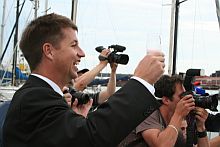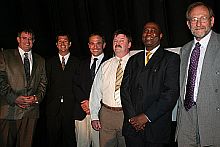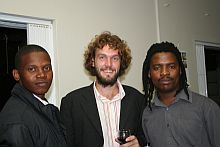Launch of exciting new ventures in marine research
|
Marine research in Africa has taken a quantum leap with the launch of three significant programmes as well as South Africa’s first in-shore research vessel at the Algoa Bay Yacht Club in Port Elizabeth on March 25.
The programmes are the Elwandle Node of the South African Environmental Observation Network (SAEON), the African Coelacanth Ecosystem Programme (ACEP), and the Agulhas and Somali Current Large Marine Ecosystem Project (ASCLME). All these programmes are hosted by the National Research Foundation's South African Institute for Aquatic Biodiversity (SAIAB).
The unveiling of the technologically advanced research vessel "uKwabelana" and its remotely operated vehicle (ROV) is being hailed as one of the most significant events in the history of marine research in Africa. SAEON provides the management system under which ACEP is run, inclusive of the deployment of the uKwabelana and its ROV for underwater observations.
At the forefront of marine sciences
According to Dr Angus Paterson, Manager of both the SAEON Elwandle Node and African Coelacanth Ecosystem Programme, the uKwabelana and submersible ROV have the potential to place the DST, NRF and research partners at the forefront of marine physical and biodiversity sciences regionally and globally.
"By generating new, cutting-edge knowledge of the largely unexplored and unknown offshore marine environment, South African marine science will be on par with the rest of the world,’’ Paterson said.
In his keynote address the Director General of the Department of Science and Technology (DST), Dr Phil Mjwara, said the event showed what can be achieved for the benefit of South Africa's economy and people.
"It is an inspiration to see programmes such as these not only develop but flourish, in spite of the current economic circumstances," he said. “This is partly due to exceptional cooperation in the scientific and research community, and co-funding from other departments and international sources.”
The South African coastal and marine environment is one of our country's most important assets, boasting extraordinary biodiversity which supports numerous local communities through fisheries, tourism and mining, and playing a major role in regulating our climate.
"South Africa has more territory under water than on dry land, yet an indication of just how little we know about the marine environment and the stresses we place on it, is the fact that it was only 10 years ago that we found a population of rare coelacanths living in the deepwater off Sodwana in Kwazulu-Natal, one of our most frequented coastal areas in the country,” Dr Mjwara said.
SAEON’s Elwandle Node - designed to address global change along the SA coast
Dr Mjwara stressed the fact that SAEON’s Elwandle Node is a DST and NRF initiative specifically designed to address global change along the South African Coast. Its key objective is to provide South African decision-makers with an understanding of the processes and outcomes of climate change. The node is built on three pillars of activities: in-situ observation, data management and education outreach.
The first of Elwandle’s three coastal sentinel sites is based in Algoa Bay, and considerable investment has been made in continuous and manual monitoring activities. It is encouraging that there has been substantial buy-in from all Elwandle’s participating local universities, museums and research facilities as well as increased participation and interest by industry through the Coega Industrial Development Zone.
Research undertaken by the Elwandle Node contributes to larger international programmes such as the International Long Term Ecological Research (ILTER) programme and the Group on Earth Observations (GEO).
African Coelacanth Ecosystem Programme - local in focus, internationally relevant
The DST has been supporting marine research on the east coast through the African Coelacanth Ecosystems Programme (ACEP) since 2002, Dr Mjwara told guests. ACEP is a flagship research programme of SAIAB, focusing on the marine environment off the East Coast of South Africa.
ACEP epitomises what collaboration can achieve, with the DST providing funding and the Department of Environmental Affairs, through its Marine and Coastal Management Division, providing the research vessel Algoa. The programme is not only interdepartmental in nature, it is also inter-institutional, with more than 10 institutions involved in the research.
"It is important to note that ACEP does not involve the study of a single species, the coelacanth, but of entire ecosystems," Dr Tommy Bornman, Coordinator of ACEP said in his address.
While the ACEP programme is local in focus, it is internationally relevant, as it is South Africa's contribution to the larger Global Environment Facility-initiated Agulhas and Somali Current Large Marine Ecosystem Project.
Agulhas and Somali Current Large Marine Ecosystem project - baseline scientific information
The ASCLME project is a major international project which South Africa is honoured to host. Focusing on the South West Indian Ocean, the project involves nine nations and aims to create a baseline of scientific information for this large marine ecosystem which can be used to ensure effective environmental governance and collaborative management.
In his address Dr David Vousden, Project Director of ASCLME said that the project was all about partnerships. "The Agulhas current, which has a major impact on the global climate, was a largely unknown area before the relationship between SAEON, SAIAB and the ASCLME came about," he explained. The close relationship between this project and ACEP has also given South African scientists unprecedented access to international cruises in the region.
Although it has hardly begun, the project has already strengthened the scientific understanding of the South West Indian Ocean, a region increasingly recognised for its role in global climate change. Dr Vousden told guests that in the short period since its inception, researchers have found a number of new species on the South West Indian Ocean ridge, and the first evidence of deepwater coral.
Describing current climate change predictions as "frightening", Dr Vousden stressed the importance of sustained long-term monitoring and comprehensive baseline data.
Leading role in global climate change research
In closing, Dr Mjwara told guests about the DST’s Global Change Grand Challenge, which focuses on climate change where South Africa's geographic position enables us to play a leading role in global climate change research.
"I must indicate that the three fundamental programmes we are launching today contribute significantly to the knowledge challenges that have emerged as part of the Global Change Grand Challenge," he said.
For further information on the SAEON Elwandle Node, the African Coelacanth Ecosystem Programme and the uKwabelana, contact Dr Angus Paterson.
Related content:
Versatile new research vessel set to boost SA marine science
Artificial reef monitoring in the iSimangaliso Wetland Park
SAEON's role in South Africa's science system
SAEON launches its Egagasini Node with key stakeholders in attendance






